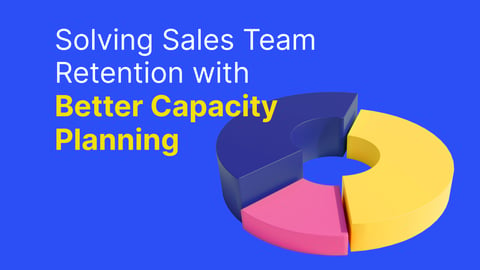An effective sales cadence is supposed to take a lead from cold to hot, from unaware to intrigued, from lead to an opportunity – right?
Here are 5 ways that sales cadences are actually killing leads:

#1 - The first touchpoint is too late
Whether it’s going on a first date, joining a new team, or responding to an inbound lead – first impressions matter. An effective inbound sales cadence is crucial in responding to leads quickly, ensuring that the sequence and frequency of communication are tailored to engage with prospects promptly.
So why does it continue to take so many “fast-moving”, “growing”, and “innovative” B2B companies so long to respond to leads when we know for a fact that there is a massive drop off the effectiveness of those responses after the first 10 minutes.
Sales tools like Salesloft and Outreach do a great job at helping us personalize outreach so we can send quality emails in a scalable way, but the problem continues to be the speed in which we get the initial responses out.

#2 - Leads are unqualified too early
Did you know 33% of leads are unqualified, moved to nurture, or removed from a sales cadences without reason?
Before disqualifying leads, it's crucial to understand their pain points to tailor communication and provide solutions that address their specific needs and difficulties. Not because the lead responded with “not right now” or “not interested” - but because the sales rep decided to stop working them.
It’s a fact that it takes much longer than just the first touchpoint, and in many cases take more than the first 10, to get a response from a lead. So why are we allowing sales reps to quit early?
Because in many businesses, there isn’t clear visibility or measurement on this. If a sales rep wants to quit on a lead, they do so and move on to the next one without consequence.

#3 - Cadences aren’t being followed
To accurately measure how sales cadences are working, sales reps have actually to follow them. A well-structured sales cadence provides a consistent sequence of touchpoints to guide prospects through the sales process. If you want to measure how 5 touchpoints vs. 20 touchpoints work over a 2-week period, your sales reps actually need to reach those touchpoints within the time period.
What we find is that reps often fall behind on their cadences, and as soon as it slips a bit, it only goes downhill from there until it is all but forgotten about. If sales reps aren’t completing cadences on a consistent basis, you can’t accurately measure them. It's as simple as that.

#4 - Sales reps are cherrypicking leads
This one comes from real customer examples we’ve seen more frequently than you’d think where sales reps are taking it upon themselves to bulk disqualify leads. Managing leads through the sales pipeline is crucial to ensure that no potential opportunities are missed. A recent example we saw is that sales reps (yes, there were multiple of them doing this,) would disqualify leads coming from a certain tradeshow the company attended without making a single touchpoint – not a call, not an email, nothing. Long story short for this company, it quickly explained why Marketing hit its lead target and Sales was short on pipeline that quarter.
Long story short, for your lead management strategy, make sure you are tracking how many touchpoints your reps are making on leads before they are moved to a nurture or disqualified stage.

#5 - Sales reps (and managers) don’t know what’s working
If you’re invested in sales cadences, your reps are likely (or they should be) using some personalization in their touchpoints – whether it’s a social interaction, use of video, or adding a personalized line at the top of an email template.
Using sales cadence examples can help understand what works by providing practical illustrations and templates for different outreach strategies. When different reps are doing different things, the goal is to replicate the successful actions and drown out the ones that aren’t effective to create playbooks to use over and over again.
The trouble is that companies aren’t stack ranking their reps against each other to draw out these top performers, and so reps continue doing what they think is best, despite having any sort of data to back them up.
Revive your lead management strategy with sales process accountability.

Full Funned Revenue Visibility
A clear look into the full-funnel – from lead to revenue.
Varicent Lift’s revenue intelligence gives sales managers the visibility into sales performance that allows them to accurately see what reps are picking up, responding to, and keeping up with assigned leads – and what ones are falling behind. This visibility is crucial in supporting the sales team by providing a systematic and structured approach to engaging with prospects. They can quickly stack rank their team to see things like:
-
how many activities each rep has with their leads in the first 30-days
-
how many leads are moving to pipeline vs. unqualified or nurture
-
the average number of touchpoints it takes each rep to qualify a lead

Sales Rep Accountability
Keeping sales reps accountable over targets, SLAs, and KPIs.
With lead management, sales reps need to be held accountable over their metrics. Phone calls are crucial in sales cadences, serving as a direct and personal communication channel to engage with prospects. If the target time to respond to a new lead is 1hr or less, and you have reps with an average time of 2hrs+, that needs immediate attention because every lead that comes in is being affected.
With lead-to-revenue alerts, sales managers are sent alerts with a summary of any health flags – like pickup rate, response time, or cadence completion – for their team highlighted. Take it a step further and set up parameters in Varicent Lift where leads that aren’t responded to in a certain timeframe are reassigned to a different sales rep.

Change behavior
The #1 way to drive revenue is to change behavior.
Lead to revenue flags are used in Salesforce cards and reports to highlight information that sales reps have forgotten to update, are falling behind on, or signify risk in the deal. Developing your own sales cadence is crucial to ensure consistent follow-ups and engagement with potential clients. They make it easy for the reps to see and provide one-click actions to move it forward. If sales reps aren’t taking action on their health flags, that information is summarized and sent to their sales manager where it becomes an opportunity for the manager to coach their team so the issues don’t come up again.




